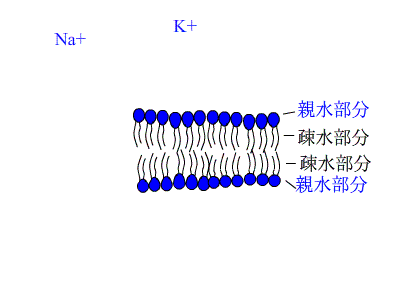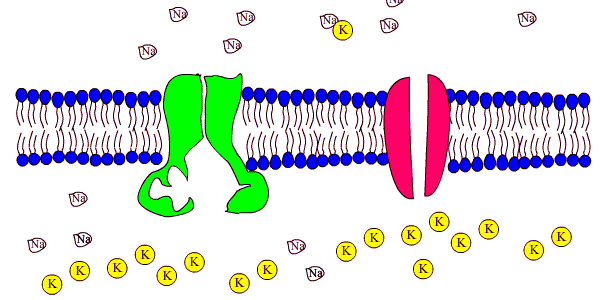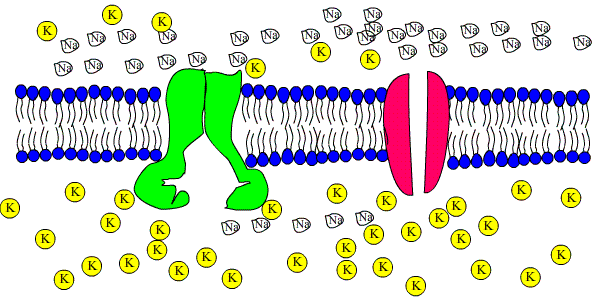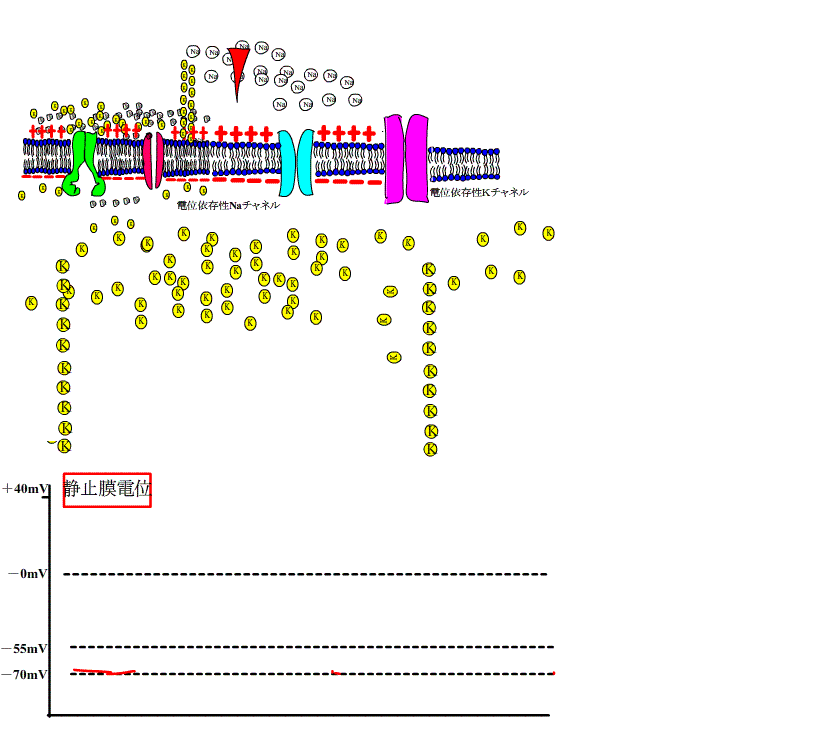Membrane potential
Humans and other living things have adapted to the outside world and have survived by fully utilizing their senses such as sight and hearing. Mammals were born because the fish, amphibians, and reptiles have survivaled on Earth.
In this section,we will consider the mechanism by which information obtained from sensory organs is converted electrically into action potentials around the cell membrane. We also think how these electrical signals reach various areas of the brain and cause changes in nerve cells or synapses.
Membrane potential
We hardly use the word, Membrane potential.All cells have different ionic composition inside and outside the cell membrane.?Therefore, the difference in the distribution of charged ions is related to the generation of membrane potential.(Please check about the charge at the following http://www.wakariyasui.sakura.ne.jp/p/elec/seidenn/dennka.html)
The movement of the cilia of Paramecium and the closing of the leaf of Mimosa pudica by touching are also likely due to changes in the membrane potential.?In this way, the membrane potential and its changes can be said to be a basic principle common to all living organisms, including unicellular organisms and plant cells.?However, the resting membrane potential of plants and fungi is negative because H+ is pumped out from the cell by the H+ pump.?Why do animals, plants and fungi have different mechanisms of resting membrane potential formation??The mystery of evolution is hidden.
| Why does the membrane potential exist??Is it necessary? |
First of all, the cell membrane allows cells to store necessities inside and to actively discharge unnecessities. It manages the environment for cells to survive.
Next, Information can be transfered very quickly by the large potential difference created inside and outside the cell membrane.
In other words, If the electric potential were a dam, the electric potential difference would be the water level difference, the ion channel would be the water gate, and the electrical energy would be the hydroelectric power generation.
When you open the gate at once,which water level is large ,the power of hydropower would be big. Similarly, opening an ion channel can produce a large electrical driving force if there is a large potential difference.
By the way, the potential difference is -70 mV around 2-3 nm the cell membrane . ( 1nm =1.0 X 10 -7th power cm) If it were the battery, the battery hight is 5 cm, so it would produce 1750 kV. Huge electromotive force is generated.
| Then, what are the characteristics of the cell membrane that creates a potential difference inside and outside the cell membrane? |
The cell membrane has a double layer of phospholipids. One layer is made up of hydrophilic and hydrophobic parts. The hydrophilic part is compatible with water and easily sticks to water-soluble material. The hydrophobic part, as the name implies,sticks to fat-soluble material.
Technically speaking, phospholipids exhibit amphipathic like surfactants , because hydrophobic fatty acid ester moieties and hydrophilic phosphate anion moieties coexist in the structure. The hydrophobic part get together inside and the hydrophilic part outside in water,and they form the vesicle- like stable lipid bilayer. Here's what's important.
Ions and lipids are not compatible with each other. In other words, substance with a charge (ions) and substance without charge (such as lipids) are not compatible.
On the other hand, uncharged molecules without positive or negativepass go through this membrane easily. So for ions, the cell membrane is the wall.

Let's see the animation on the left.?Na and K ions cannot pass.?CO2 and O2 without polarity can pass through.?Water is polar, though its low molecular weight allows it to pass through slowly.?Glucose, non-polar, has a large molecular weight and passes slowly.
?
| How can the difference in ion concentration be made? |
If Na+ ions are pumped out of the cell and K+ ions are pumped in the cell, Na+ ions increase outside the cell and K+ ions increase inside the cell.?This creates a difference in ion concentration.
We need a pump for pumping.?This is called an ion pump, and a sodium-potassium pump is common.

The green color represents the NaK pump.?The energy of pump is ATP.?Organisms use 30% of all ATP to power this NaK pump.
ATP sticks to the pump and becomes ADP and phosphoric acid.?During this time, the released energy causes the three Na ions in the cell to stick together and the pump to move.?At the same time, two K ions outside the cell stick to each other and move into the cell. Then the part where Na and K ions stick together is deformed, and this increase three Na ions outside the cell and two K ions inside the cell at last.
If there is a difference in ion concentration, it is considered that there is a potential difference from the beginning, but it is different.
Here, when considering the inside and outside of the cell separately, there are many charged ions.However considering as a whole, charging inside and outside are the same.
There is the "electroneutrality principle", and the number of positive charges in a solution is always balanced with the same negative charge.?All cells, intracellular and extracellular fluid follow this principle.
| The membrane potential is formed by the tiny charge moving in the vicinity of the cell membrane. |
Therefore, its effect on the distribution of intracellular and extracellular fluids in large volumes is negligible.
If the solution is electrically biased, it cannot maintain a stable state.?Therefore,?there is a difference in ion concentration inside and outside?the?cell, but that does not create a potential difference between the membranes. It sounds complicated.?
In this state, the positive and negative amounts inside and outside the cell are the same, so no electric potential is generated on the membrane.
Here is the channel in the membrane.?The leak channel?.?This opens all the time.
Only K+ ions pass this channel.
Since there are very few K+ ions outside the cell?, K+ ions naturally pass through the channel and go out of the cell according?to a concentration gradient (?also called a?chemical gradient?).
It is not untill concentration inside and outside the cell become the same that the ions stop going out.
It is until anion inside the cell attract K+ ion. K+ ion does not go out more than that even if there is a difference in concentration, .
This?is called?an?electric gradient,?and ultimately, the sum of these two gradients, that is, the?electrochemical gradient?,?causes?the movement of K ions.

Outflow of K+ ions from the leak channel increases the number of negative ions inside the cell, and the?resting membrane potential?becomes?-70 mV?.
Next, as shown in the animation below, when a certain stimulus (arrow) is applied to the membrane, local depolarization of the membrane happens, that is, the intracellular potential shifts slightly from negative to positive, the potential changes.
This opens the voltage-gated Na+ channels in the surface of cell's membrane.?Extracellular Na+ ions flow into the cell according to a concentration and electrical gradient.?As Na+ inflows and the negative charge of the membrane potential decreases, the Na+ channel opens further and Na+ flows more.?The membrane potential reverses and becomes positive inside the cell.?This is also depolarization.?It means that the polarized state, that is, the potential is divided into plus and minus inside and outside the membrane, is released.
There are a few things to note here.?This phenomenon is such very little ion movement at every stage of the action potential, and changes in Na+ and K+ ion concentrations inside and outside the cell are small enough to be ignored.
When the membrane potential reaches about +30 mV, the voltage-dependent Na+ channel closes and the Na+ influx ends.?After a short delay, the voltage-gated K+ channel is activated and the channel opens.
Intracellular K+ flows out of the cell according to a concentration gradient and an electrical gradient.?This reverses the membrane potential and causes repolarization.
Even after the membrane is sufficiently repolarized, K+ ions continue to flow out of the cell, temporarily causing the membrane potential to become even lower than the normal resting membrane potential.?This is called hyperpolarization,that is, polarization has passed.


